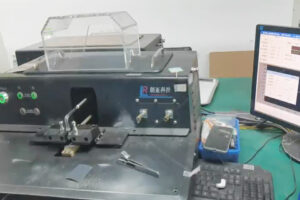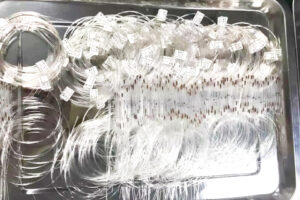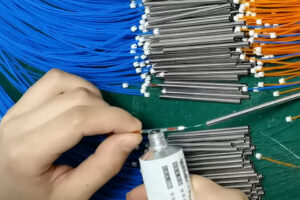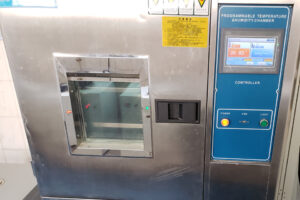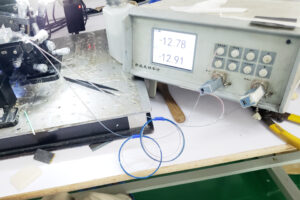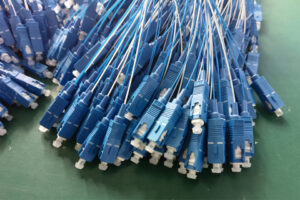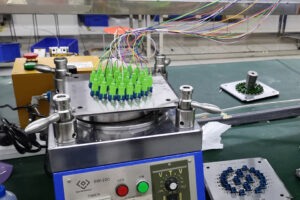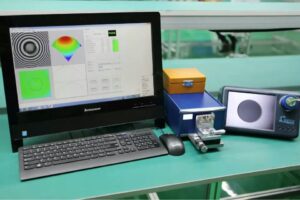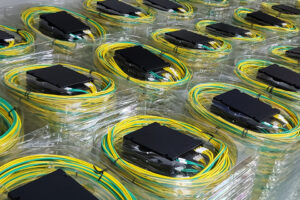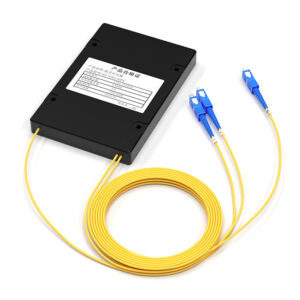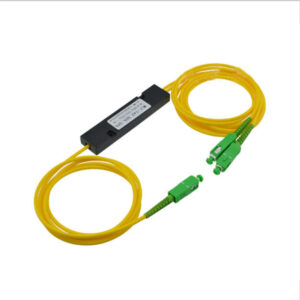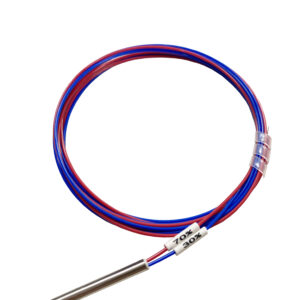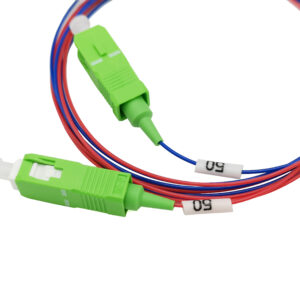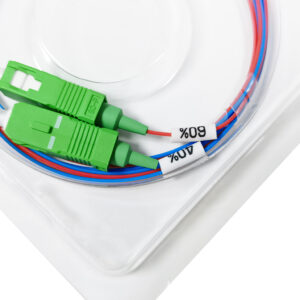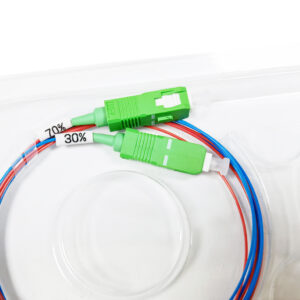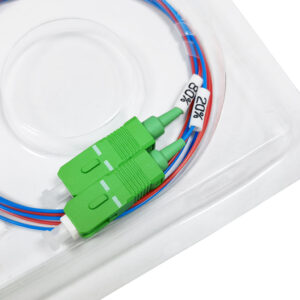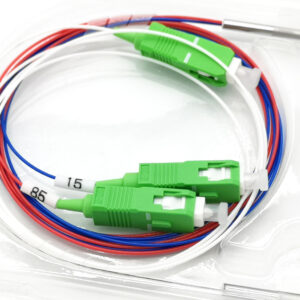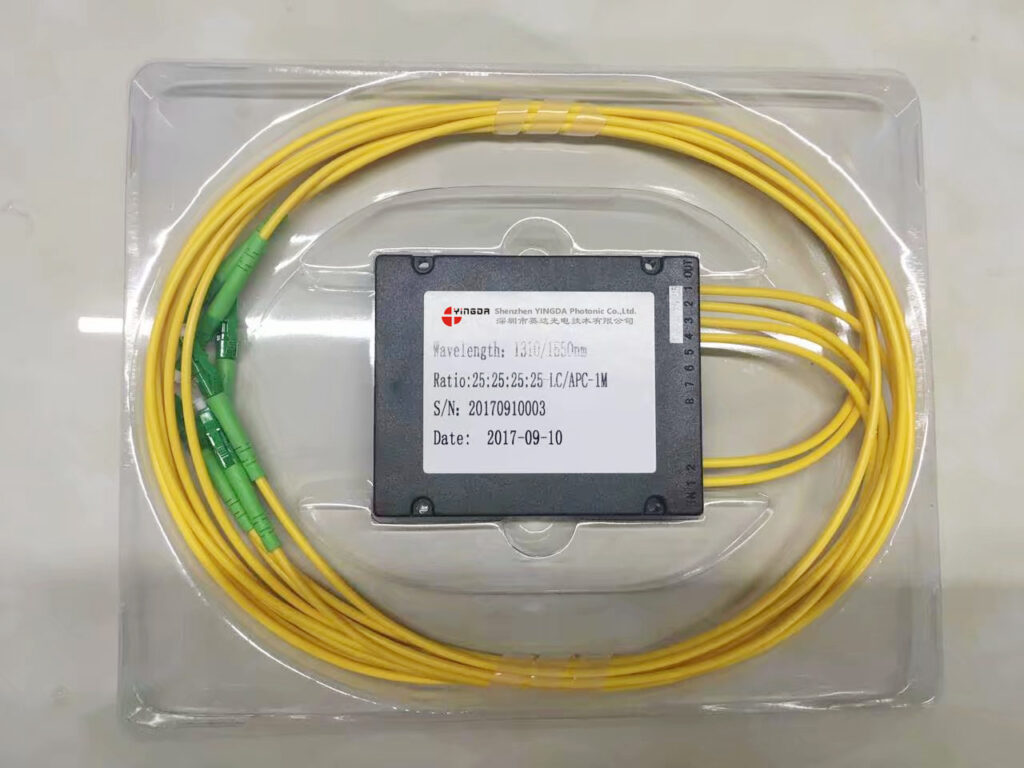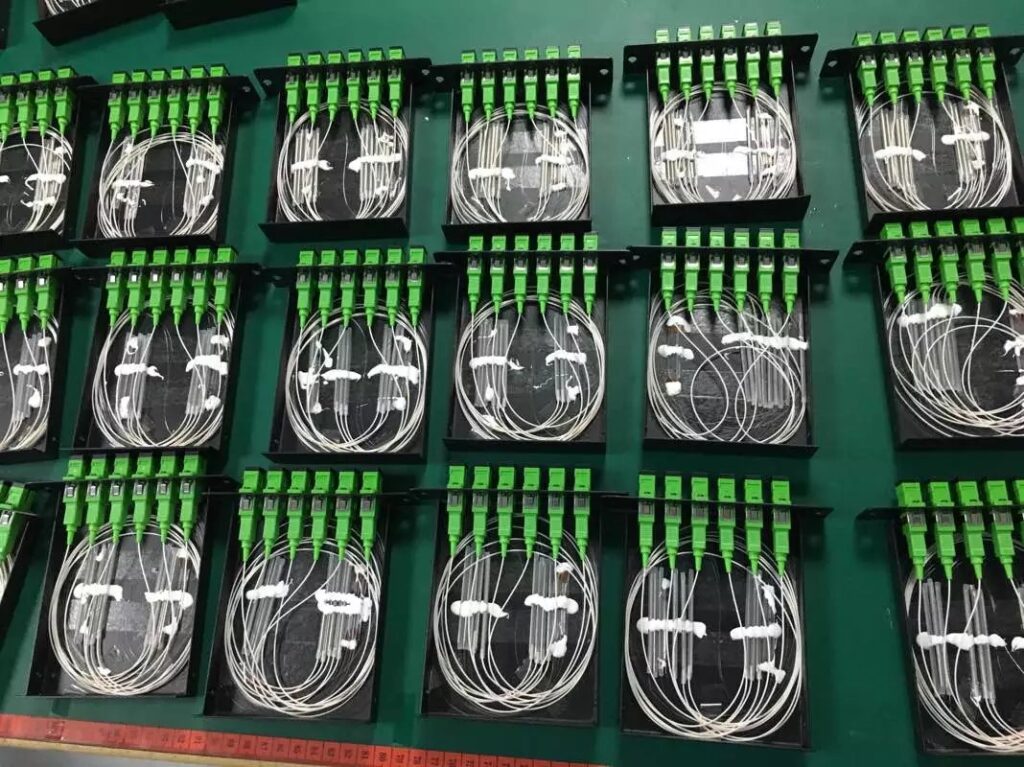FBT Coupler
Fiber optic splitter is an optical passive device that decomposes a fiber signal into two or more optical signals according to a predetermined proportion for output, and is connected to FTTH mode. According to the different principles of optical splitting and manufacturing processes, optical splitters can be divided into two types: fused biconical (FBT) and planar waveguide (PLC).
The FBT splitter is produced using the traditional taper coupler process, which bundles two or more coated optical fibers together, and then heats and melts them at high temperature on the taper puller. At the same time, it stretches to both sides and monitors the changes in the splitting ratio in real-time. After the splitting ratio meets the requirements, the melting and stretching process ends, and finally, a special waveguide structure in the form of a double cone is formed in the heating zone. One end retains a fiber optic cable (the rest is cut off) as the input end, and the other end serves as the multi-channel output end. By controlling the angle of fiber twisting and the length of stretching, different splitting ratios can be obtained. Finally, solidify the pulling cone area with curing adhesive onto a quartz substrate and insert it into a stainless steel tube.
At present, the mature cone pulling process can only pull 1×4 or less at a time. If output more, multiple 1×2 are used to connected together and then pack as a set in a module.
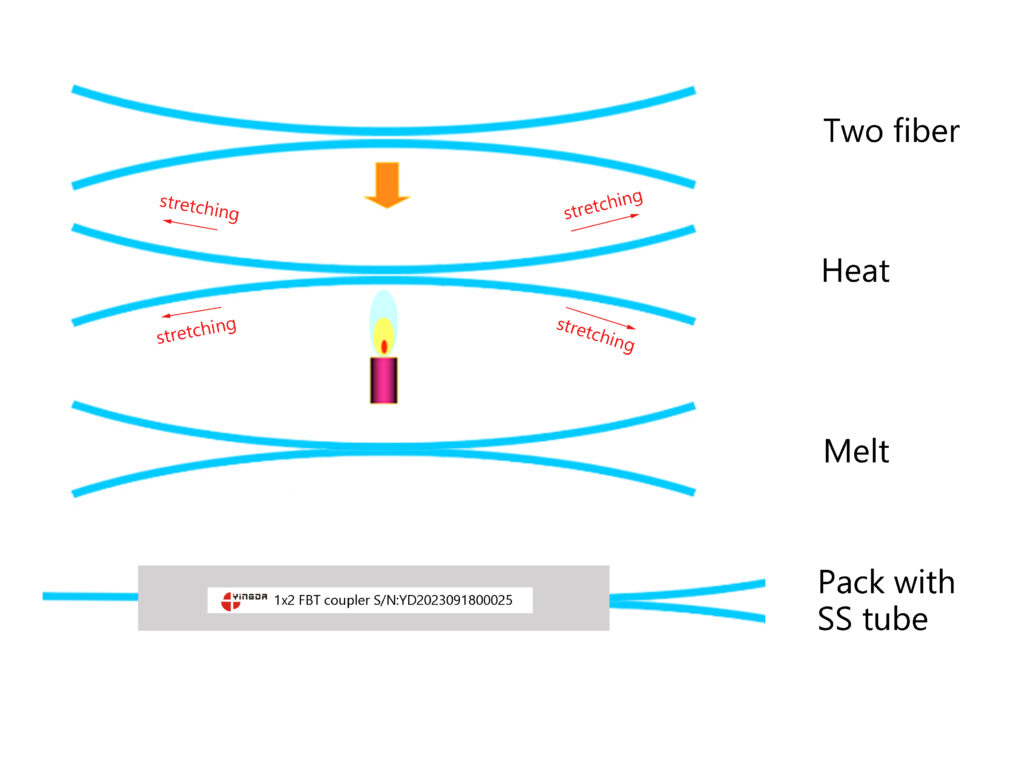
Features
- Low addtional lost
- Low PDL
- Good stability
- Optional single window, dual window, triple window
- High wavelength isolation
- Small volume, light weight
- Optional split ratio, balanced or unbalanced
Application
- Fiber optic communication system
- Fiber optic LAN network
- CATV network
- FTTH network
- Fiber optic sensor
- Measuring instruments
Production Process
All of Yingda’s products are made of brand new raw materials and 100% inspection before delivery. Refuse to inferior quality products and unqualified products to impact the market or damage the interests of customers. The production process mainly include:
- Pulling cone: Melt and pull several optical fibers into the initial components with a specified splitting ratio on the pulling cone machine;
- Glue Injection: add glue on the coupler inner device and heat oven
- Second sealing: perform the second sealing after penetrating the steel pipe;
- Circulation: high and low temperature circulation from -40℃to+85℃ for 8 hours;
- Testing: Test various performance indicators according to the requirements of the production order;
- Assembly: assemble the qualified products into module or boxes
- Grinding: add connectors and end face grinding
- Testing: Performance test after polished
- Packaging and warehousing: Put qualified products into packaging boxes, store and ship them
Product Category
Yingda design and make all kinds of fused couplers or splitters with ISO certified. And we can pack with stainless tube, small cassette, ABS module or LGX metal box or even in splice closures, ODF tray, or distribution boxes.
Note: if 1×4 or bigger split ratio, can only do ABS module, and 3*3 can only be a single window, 1*3 dual window can only be made in ABS module type.
Steel Tube Mini FBT Splitter
Steel tube mainly have 3 different size:
Type D:¢3mm x 45mm;
Type E:¢3mm x 54mm;
Type F:¢3mm x 60mm.
Suitable for 1×2 2×2 couplers.
Pigtail type: 250um bare fiber or 900um loose tube.
The split ratio will be customized from 1/99, 2/98, … 10/90, 15/95, 20/80, 25/75, 30/70, 35/65, 40/60, 50/50.
Wavelength: 1310nm, 1490nm 1550nm, or 1310/1490nm,1310/1550nm, 1490/1550nm, or 1310/1490/1550nm.
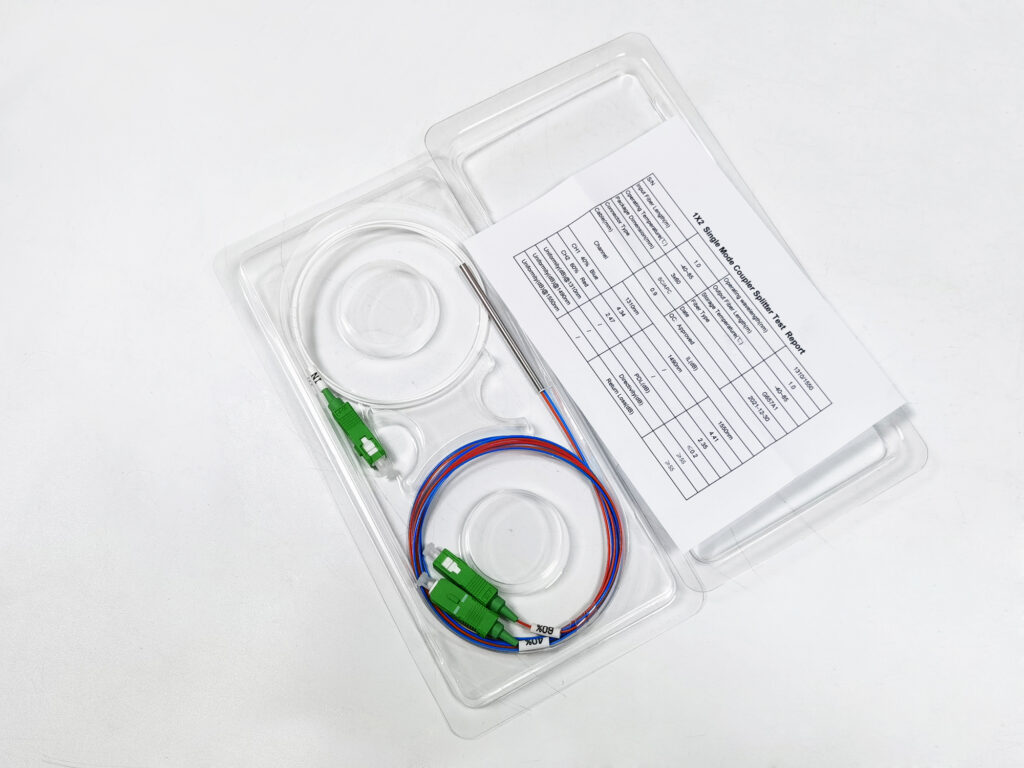
Cassette FBT Coupler
Type G cassette size: 10*20*90mm, suitable for 1×2 2×2 couplers, cable type:2mm 3mm, with or without connectors.
Pigtail type: 2mm,3mm cable or 900um loose tube
The split ratio will be customized from 1/99, 2/98, … 10/90, 15/95, 20/80, 25/75, 30/70, 35/65, 40/60, 50/50.
Wavelength: 850nm, 1310nm, 1490nm 1550nm, or 1310/1490nm,1310/1550nm, 1490/1550nm, or 1310/1490/1550nm.
Connector type: SC LC FC ST
Polish Method: UPC APC PC
ABS Module FBT Coupler
Type H ABS box size:10*80*100mm, suitable for 1×3, 1×4 1×5 1×6 1×8 etc., cable type:2mm 3mm, with or without connectors.
Pigtail type: 2mm,3mm cable or 900um loose tube
The split ratio will be customized from 1/99, 2/98, … 10/90, 15/95, 20/80, 25/75, 30/70, 35/65, 40/60, 50/50.
Wavelength: 850nm, 1310nm, 1490nm 1550nm, or 1310/1490nm,1310/1550nm, 1490/1550nm, or 1310/1490/1550nm.
Connector type: SC LC FC ST
Polish Method: UPC APC PC
Free Samples Available
Only 2steps to get free samples from Yingda, help seize market share and win the bid in the fastest time.
Product Details
Blister Box Individual Pack
Test Report
Block For Output Pigtails
Block For Input Pigtail
"IN" for Input Pigtail
Mark of Split Ratio
Technical Parameters
Single Mode FBT Coupler | ||
Grade | P Grade | A Grade |
Spectral ratio (%) | 1~50 | 1~50 |
Additional loss (typical value) (dB) | 0.07 | 0.1 |
Insertion loss (max. value) (dB) | 3.4 | 3.5 |
Polarization sensitivity (dB) | 0.1 | 0.15 |
Working wavelength (nm) | 1310±40,1550±40, 1585±40, or custom wavelength | |
Directionality (dB) | ≥55 | |
Working temperature(℃) | -20 ~ +85 | |
Storage temperature(℃) | -40 ~ +85 | |
Fiber type | Corning single mode SMF-28,DS fiber or flexcore | |
Pigtail length (m) | 1 | |
Port / Channel | 1×2 or 2×2,1X3, 1X4, etc | |
Package size (mm) | Package D,E,F,G,H | |
FBT Splitter Loss Chart
Split ratio | Insertion loss (unit:dB) | |
P grade | A grade | |
40/60 | 4.4/2.5 | 4.6/2.8 |
30/70 | 5.6/1.8 | 6.0/2.0 |
20/80 | 7.4/1.1 | 7.7/1.3 |
10/90 | 10.8/0.6 | 11.6/0.8 |
5/95 | 14.2/0.4 | 14.6/0.5 |
2/98 | 18.5/0.2 | 19.0/0.3 |
1/99 | 21.0/0.2 | 21.5/0.3 |
Frequently Asked Questions
With more than 10 years fiber optic experience, we help solved many problems with the use, features, applications or price. Below mainly describe popular questions for your reference. Any more questions, pls contact our sales representatives.
What is dual window?
Window means the operation wavelength, single mode splitter FBT can work at 1310nm, 1490nm, 1550nm.
- If the same device can work at only one of the three wavelength, for example 1310nm, that means it is single window coupler. There are 3 types of single window coupler, they are1310nm coupler, 155nm coupler, 1490nm coupler.
- If work at both of the three wavelength, for example 1310/1490nm, then will be called dual window coupler. There are 3 types of dual window coupler, they are 1310/1490nm coupler, 1310/1550nm coupler, 1490/1550nm coupler.
- If work at all of three wavelength 1310/1490/1550nm, that meand triple window coupler or three window coupler.
What is a FBT coupler?
FBT coupler is fused biconical taper coupler, it was made by fusion, and divide light from 1 channel into 2 or more channels in balanced or unbalanced split ratio.
What is the difference between PLC splitter and FBT coupler?
- The production artwork is different. PLC splitter adopt plana lightwave circuit technology, complex manufacturing process, no need fusion, but with chips to make product fast. FBT coupler is by heat melting traditionally method, it is low productivity.
- The operation wavelength differs: PLC splitter support 1260-1650nm wavelength, FBT splitter can only support in a few wavelength, like 850nm, 1310nm, 1550nm, 1490nm. So PLC Splitter application is more.
- For 1×2 splitter, the FBT splitter is cheaper, but if outputs more, PLC splitter is more competitive.
- But with the FTTR application emerging, FBT splitter+PLC Splitter combined unbalanced splitters are in large demand now.
- Splitter is balanced split ratio, but coupler is unbalanced splitter, can custom according to customer’s request.
What is the output of an FBT coupler ?
FBT fiber coupler is a device used to achieve the splitting and merging of light wave energy. It distributes the light energy transmitted in a single fiber to two or more fibers in a predetermined proportion, or synthesizes the light energy transmitted in multiple fibers into one fiber.
Normally the input of coupler is 100% optical power, and then the output of an FBT coupler divide and distribute the optical power from the input by a predetermined proportion. The commonly used description is MXN, where M is usually the input end and typically consists of 1 or 2 pigtails. N is the output end, usually 2 4 8 16 32 64 128, but with the further development of FTTR, non-standard outputs such as 3 5 6 9 12 24 have also been found, such as 1×3 splitter, 1×5 splitter, 1×9 splitter are widely used in fiber optic network.
What is FBT in fiber optics?
FBT is fused biconical taper, it is a traditional technology in fiber optics. When two fibers are placed closely together, typically twisted around each other, fused together by heat while the assembly is being elongated and tapered.
Is a coupler the same as a splitter?
Their function are the same, both can divide or combine light power, both but structure and details are different. Their working wavelength are quite different, splitter is full range, coupler only 4wavelength.
What is 2x2 fiber coupler?
2×2 fiber coupler is 2pcs input fiber and 2pcs output fiber optic pigtails. It is better than 1×2 fiber coupler. The 2xN series is mainly used in the Middle East region. The advantage of this solution is that if one of the incoming fibers is damaged, there is another reserved fiber that can be used, reducing maintenance costs. But the prerequisite investment will be a bit larger.
What is the FBT optic splitter advantage & disadvantages ?
Advantages
The taper coupler has a history and experience of over 20 years, and many equipment and processes only need to be used, with development costs only a few tens or even a few hundred times that of PLC;
The raw materials only include easily obtainable quartz substrates, optical fibers, heat shrink tubes, stainless steel tubes, and a small amount of adhesive, totaling no more than one dollar And the investment depreciation cost of machines and instruments is even lower, The cost of low channel like 1×2, 1×4 splitter is low;
The splitting ratio can be monitored in real-time as needed, and unequal splitting splitters can be made.
Disadvantages
Loss is sensitive to the wavelength, and devices are generally selected based on the wavelength. This is a fatal flaw in the process of using the three networks in one, as the optical signals transmitted in the three networks in one include multiple wavelength signals such as 1310nm, 1490nm, 1550nm, etc;
Poor uniformity(refers to the change of insertion loss at each output that evenly distributes light). The nominal maximum difference of 1X4 is about 1.5dB, 1×8 is even greater. Coupler cannot ensure uniform light splitting and may affect the overall transmission distance. Currently, mature cone pulling processes can only pull less than 1×4 at a time, more outputs above 4 will use multiple 1×2 couplers and then pack as a whole in a box;
The insertion loss varies greatly with temperature (TDL) (Insertion loss refers to the ratio of the output optical power of a port to the input optical power). Insertion loss is composed of two parts: one is additional loss, and the other is spectral ratio factor; The insertion loss varies depending on the spectral ratio of the device, therefore; There are no specific provisions in the standard;
Multiplex splitter such as 1×16, 1×32, the volume is relatively large, and the reliability will also be reduced, resulting in limited installation space.
The FBT splitter only supports 4 wavelengths: 850nm, 1310nm, 1490nm, and 1550nm, which makes it unable to operate at other wavelengths.

